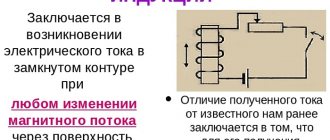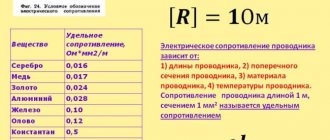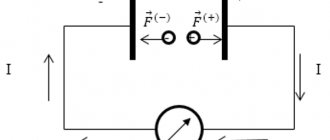Mysterious quantum phenomena still surprise researchers with their unimaginable behavior. Earlier we talked about superfluidity, today we will consider another quantum mechanical phenomenon - superconductivity.
What is superconductivity? Superconductivity is a quantum phenomenon of the flow of electric current in a solid body without losses, that is, with strictly zero electrical resistance of the body.
Background
With the introduction of the concept of “absolute zero” into physics, scientists began to increasingly study the properties of substances at low temperatures, when there is practically no movement of molecules. To achieve low temperatures, a process called “gas liquefaction” is required. When evaporating, such a gas takes energy from the body that is immersed in this gas, since energy is required to separate molecules from the liquid. Similar processes occur in household refrigerators, where liquefied freon gas evaporates in the freezer.
At the end of the 19th and beginning of the 20th centuries, liquefied gases such as oxygen, nitrogen, and hydrogen were already produced. For a long time, helium could not be liquefied, but it was expected that it would help achieve a minimum temperature.
Heike Kamerlingh Onnes (right) with assistant Gerrit Flim (left)
Success in the liquefaction of helium was achieved by the Dutch physicist Heike Kamerlingh-Onnes in 1908, who worked at the University of Leiden (Netherlands). Liquefied helium made it possible to reach a record low temperature - about 4 K. Having received liquid helium, the scientist began to study the properties of various materials at helium temperatures.
History of discovery
One of the questions that interested Kamerlingh Onnes was the study of the resistance of metals at ultra-low temperatures. It was known that as temperature increases, electrical resistance also increases. Therefore, we can expect that the opposite effect will be observed as the temperature decreases.
Experimenting with mercury in 1911, the scientist brought it to freezing and continued to lower the temperature. When 4.2 K was reached, the device stopped recording resistance. Onnes replaced the devices in the research facility because he was afraid they would malfunction, but the devices consistently showed zero resistance, despite the fact that absolute zero was still 4 K away.
After the discovery of superconductivity of mercury, a large number of questions arose. Among them: “is superconductivity characteristic of substances other than mercury?” or “the resistance drops to zero, or it is so small that existing devices cannot measure it.
Onnes proposed an original study that indirectly measured to what level resistance was reduced. The electric current excited in a semiconductor circuit, which was measured by deflecting a magnetic needle, did not die out for several years. According to the results of this experiment, the electrical resistivity of the superconductor obtained through calculations was 10−25 Ohm•m. Compared to the electrical resistivity of copper (1.5۰10−8 Ohm•m), this value is 7 orders of magnitude less, which makes it practically zero.
Superconductivity temperature of metals, alloys and other materials:
| Materials | Critical temperature, K | Critical fields (at 0 K), G (E*) | |
| Type 1 superconductors | Hc | ||
| Rhodium | 0,000325 | 0,049 | |
| Magnesium | 0,0005 | —** | |
| Tungsten | 0,012 | 1* | |
| Hafnium | 0,37 | —** | |
| Titanium | 0,39 | 60 | |
| Ruthenium | 0,47 | 46* | |
| Cadmium | 0,52 | 28 | |
| Zirconium | 0,55 | 65* | |
| Osmium | 0,71 | 46,6* | |
| Uranus | 0,8 | —** | |
| Zinc | 0,85 | 53 | |
| Gallium | 1,08 | 59 | |
| Aluminum | 1,2 | 100* | |
| Rhenium | 1,7 | 188* | |
| Bilayer graphene | ~1,7 | 500 | |
| Au-Bi alloy | 1,84 | —** | |
| Thallium | 2,37 | 180 | |
| Indium | 3,41 | 280 | |
| Tin | 3,72 | 305 | |
| Mercury | 4,15 | 411 | |
| Tantalum | 4,5 | 830* | |
| Vanadium | 4,89 | 1340* | |
| Lead | 7,1999 | 803 | |
| Technetium | 11,2 | —** | |
| H2S ( hydrogen sulfide ) | 203 at a pressure of 150 GPa | 720 000 | |
| Type 2 superconductors | Hc1 | Hc2 | |
| Niobium | 9,25 | 1735 | 4040 |
| Nb3Sn | 18,1 | – | 220 000 |
| Nb3Ge | 23,2 | – | 400 000 |
| Pb1Mo5,1S6 | 14,4 | – | 600 000 |
| YBa2Cu3O7 | 93 | 1000*** | 1 000 000*** |
| HgBa2Ca2Cu3O8+x | 135 | —** | —** |
Note to the table:
* for materials marked * the value of the critical field is indicated in E (oersted), for the rest in Gs (Gauss).
** - no data.
*** Extrapolated to absolute zero.
Meissner effect
In addition to superconductivity, superconductors have another distinctive feature, namely the Meissner effect. This is the phenomenon of rapid decay of the magnetic field in a superconductor. A superconductor is diamagnetic, that is, in a magnetic field, macroscopic currents are induced in the superconductor, which create their own magnetic field, which completely compensates for the external one.
Magnet levitating above a high-temperature superconductor cooled by liquid nitrogen
The Meissner effect disappears in strong magnetic fields. Depending on the type of superconductor (more on this later), the superconducting state either disappears completely (type I superconductors), or the superconductor is segmented into normal and superconducting regions (type II). It is this effect that can explain the levitation of a superconductor above a strong magnet, or a magnet above a superconductor.
Magnetic fields
Similarly, at a fixed temperature below the critical temperature, superconducting materials stop superconducting when an external magnetic field that is greater than the critical magnetic field is applied. This occurs because the Gibbs free energy of the superconducting phase increases quadratically with the magnetic field, while the free energy of the normal phase is approximately independent of the magnetic field.
If the material is superconducting in the absence of a field, then the free energy of the superconducting phase is less than that of the normal phase, and therefore for some finite value of the magnetic field (proportional to the square root of the difference in free energies at zero) the two free energies will be equal and a phase transition to normal will occur phase.
More generally, higher temperatures and stronger magnetic fields result in a smaller proportion of superconducting electrons and therefore greater penetration of external magnetic fields and currents into London. The penetration depth becomes infinite during the phase transition.
Figure 6. Meissner effect
Conclusion
From all of the above, we can conclude that superconductivity is an extremely interesting and not yet fully understood feature of various substances. But the main disadvantage that prevents the introduction of superconductors into everyday life is the low temperatures at which substances transition into the superconducting state.
And if we can overcome this disadvantage, superconductors will change our daily lives and the level of earthly technology. After all, almost a hundred years after the discovery of superconductivity, it has turned from a unique and laboratory-curious phenomenon into a generally accepted fact and a source of billions of dollars in income for enterprises in the electronics industry.
Bibliography
- RUSSIAN ACADEMY OF SCIENCES INSTITUTE OF PHYSICS OF MICROSTRUCTURES. As a manuscript, Vladislav Viktorovich Kurin, Physics of Superconductors. Introductory course.
- Textbook for 4.5 year students of the Faculty of Radiophysics (RF) and the Higher School of General and Applied Physics (HSOPF) of the UNN named after. Lobachevsky, Nizhny Novgorod, 2004
- Zakharova E. I., Suyundikov M. M. Application of high-temperature superconductivity in the metallurgical industry [Text] // Technical sciences in Russia and abroad: materials of the V International. scientific conf. (Moscow, January 2016). - M.: Buki-Vedi, 2016. - pp. 23-29. - Internet
If you liked the page, share it on social networks:
Theoretical explanation of the superconductivity effect
Phenomenological approach. Although Kamerlingh Onnes is the discoverer of superconductivity, the first theory of superconductivity was first proposed in 1935 by German physicists and brothers Fritz and Heinz London. Scientists sought to mathematically record such properties of a superconductor as superconductivity and the Meissner effect, without delving into the microscopic causes of superconductivity, phenomenologically. The derived equations made it possible to explain the Meissner effect in such a way that an external magnetic field could penetrate into a superconductor only to a certain depth, depending on the so-called London penetration depth. To explain superconductivity, it was necessary to assume that the current carriers in a superconductor, as in a metal, are electrons. At the same time, zero resistance means that the electron does not experience collisions during its movement. Since this applies to all conduction electrons, there is a current of electrons without resistance.
Obviously, this theory does not explain the very nature of this phenomenon, but only describes it and allows us to predict its behavior in a number of cases. A deeper, but also phenomenological theory was proposed in 1950 by Soviet theoretical physicists Lev Landau and Vitaly Gnizburg.
A Cooper pair of electrons moving through a lattice of positive atoms. The first electron distorts the lattice, creating a region of increased positive charge into which the second electron is drawn.
BCS theory. The first qualitative explanation of the phenomenon of superconductivity was proposed within the framework of the so-called BCS theory, constructed by American physicists John Bardeen, Leon Cooper and John Schrieffer. This theory comes from the assumption that attraction can arise between electrons under certain conditions. Attraction, which is caused by various excitations, primarily by vibrations of the crystal lattice, is capable of creating “Cooper pairs” - bound states of two electrons in a crystal. Such a pair can move in a crystal without being scattered either by vibrations of the crystal lattice or by impurities. In substances with a temperature far from zero, there is enough energy to “break” such a pair of electrons, while at low temperatures the system does not have sufficient energy. As a result, a flow of bound electrons - Cooper pairs - appears, which practically do not interact with the substance. In 1972, D. Bardeen, L. Cooper and D. Schrieffer received the Nobel Prize in Physics.
Later, the Soviet theoretical physicist Nikolai Bogolyubov improved the BCS theory. In his works, the scientist described in detail the conditions under which Cooper pairs can be formed (energy close to the Fermi energy, certain spins, etc.) as a result of quantum effects. Individually, electrons are particles with half-integer spin (fermions) that are unable to form a Bose-Einstein condensate and become superfluid. When there is a Cooper pair of electrons, then it represents a quasiparticle with integer spin and is a boson. Under certain conditions, bosons are capable of forming a Bose-Einstein condensate, that is, a substance whose particles occupy the same state, which leads to the occurrence of superfluidity. This superfluidity of electrons explains the effect of superconductivity.
From state support to private investment
Experts predict fairly active development of the global and Russian superconductor market. Thus, Andrey Vavilov, Chairman of the Board of Directors of SuperOx CJSC, notes that the volume of the global HTSC market is doubling every year and will reach $1 billion in 2022, while the Russian Federation’s share in the global market can be estimated at approximately 10%.
“The market for superconductivity for the electric power industry must develop, since the density of energy consumption is constantly growing and without superconductivity it is impossible to support growing demands,” says Vitaly Vysotsky. “However, power engineers are very conservative in relation to everything new, and even expensive. Therefore, for now the main task is to promote new projects with the support of government organizations. This will be proof of the reliability and efficiency of superconducting devices. The emergence of new projects will create demand for the production of HTSC tapes, increase their output and reduce prices, which will again help market development.”
“At this stage, a comprehensive solution to all the tasks set is impossible without the full assistance of the state, but every year the investment attractiveness of HTSC technology increases, which allows us to expect with a high degree of confidence an influx of private investment in its further commercial development,”
— Viktor Pantsyrny agrees with his colleague.
Experts are pleased that in general there is an understanding at the state level of the importance of superconducting technologies.
“The development of the superconductor industry is of national importance and is an important part of the transition to an innovative path of development of the country’s economy. This was recently stated at an extended meeting of the Advisory Council under the Chairman of the State Duma Committee on Energy of the Federal Assembly of the Russian Federation, where, in particular, it was noted that in order to ensure the economic and political independence of Russia, it is strategically necessary to have domestic production of low- and high-temperature superconducting materials, superconducting devices and products based on them",
— Viktor Pantsyrny reports.
Superconductors in an alternating electric field
In addition to superconductivity and the Meissner effect, superconductors have a number of other properties. It is worth noting the following - zero resistance of superconductors is characteristic only at constant current. An alternating electric field makes the resistance of the superconductor non-zero and it increases with increasing field frequency.
Just as the two-fluid model divides a superfluid material into a region of superfluidity and a region of ordinary matter, so the flow of electrons is also divided into superconducting and ordinary. A constant field would accelerate superconducting electrons to infinity (given their zero resistance), which is impossible, because it turns to zero when they hit the superconductor. Since a constant electric field does not act on superconductors, ordinary electrons are not affected by it (it is simply pushed out), which means that the movement is represented only by superconducting electrons.
In the case of an alternating electric field, the process of acceleration of electrons occurs followed by deceleration, which is physically possible. In this case, there is also a current of ordinary electrons, which have the property of resistance. The higher the frequency of such a field, the greater the effects associated with ordinary electrons.
London moment
Another interesting property of a superconductor is the London moment. The essence of the phenomenon is that a rotating superconductor creates a magnetic field that is aligned exactly along the axis of rotation of the conductor.
Further study of this phenomenon led to the discovery of London's gravity magnetic moment. In 2006, researchers Martin Tajmar from the ARC Seibersdorf Research Institute, Austria, and Clovis de Matos from the European Space Agency (ESA) discovered that a spinning superconductor also generates a gravitational field. However, such a gravitational field is approximately 100 million times weaker than the earth's.
Classification of superconductors
There are several classifications of superconductors, which are based on the following criteria:
- Response to a magnetic field. This property divides superconductors into two categories. Type I superconductors have a certain critical magnetic field value, exceeding which they lose superconductivity. Type II - have two limiting values of the magnetic field. When a magnetic field limited to these values is applied to superconductors in this category, the field partially penetrates while maintaining superconductivity.
- Critical temperature. There are low-temperature and high-temperature superconductors. The former have the property of superconductivity at temperatures below −196 °C or 77 K. High-temperature superconductors require a temperature higher than this. This division occurs because high-temperature superconductors can be used in practice as coolers.
- Material. Here there are such varieties as: pure chemical element (like mercury or lead), alloys, ceramics, organic or iron-based.
- Theoretical description. As is known, any physical theory has a certain scope of application. For this reason, for further application, it makes sense to divide superconductors according to theories that can describe their nature.
Superconductivity, phenomenon, discovery, theory, application and temperature of superconductivity.
Superconductivity is the property of some materials to have absolutely zero electrical resistance when they reach a temperature below a certain value (the so-called critical temperature).
Description. The phenomenon of superconductivity
Discovery of superconductivity
Nature, explanation and theory of superconductivity
Classification, types and types of superconductors
Superconductivity temperature of metals, alloys and other materials
Properties of superconductors. Effects of superconductivity
Applications of Superconductivity
Superconductivity of graphene
Over the past few years, graphene's popularity has increased significantly. Let us recall that graphene is a layer of modified carbon, one atom thick. First of all, this was facilitated by the discovery of carbon nanotubes - a specific ultra-strong material that is created by folding one or several layers of graphene.
Large-scale simulation of a structure formed when one graphene lattice is rotated at a "magic angle" relative to a second graphene lattice
In 2018, a group of researchers from the Massachusetts Institute of Technology and Harvard University, led by Professor Pablo Jarillo-Herrero, discovered that when rotated at a certain (“magical”) angle, two sheets of graphene are completely devoid of electrical conductivity. When the researchers applied a voltage to the material by adding a small number of electrodes to this graphene structure, they found that at a certain level, electrons broke free of their original insulating state and flowed without resistance. The most important feature of this phenomenon is that the superconductivity of the specified graphene structure was obtained at room temperature. And although the explanation for this effect is still in question, its potential in the energy supply sector is quite high.
AC cables
It is impossible not to talk about the Russian project to create a superconducting cable 200 m long. The JSC Energy Institute named after. G.M. Krzhizhanovsky" (ENIN), OJSC "All-Russian Scientific Research Institute of the Cable Industry" (VNIIKP), Moscow Aviation Institute and OJSC "Scientific and Technical Center of Electric Power Industry". Development began in 2005; in 2009, a prototype was created, which was successfully tested at a specially created unique test site.
The main advantages of HTSC cable are high current load, low losses, environmental friendliness and fire safety. In addition, when transmitting high power via such a cable at a voltage of 10–20 kV, intermediate substations are not required.
HTSC cable is a complex multilayer structure. The central supporting element is made in the form of a stainless steel spiral, surrounded by a bundle of copper and stainless steel wires wrapped with copper tape. Two layers of superconducting tapes are laid on top of the central element, and high-voltage insulation is placed on top. This is followed by the application of a superconducting screen, a layer of flexible copper tapes wrapped with stainless steel tape. Each cable core is pulled into its own flexible cryostat 200 m long.
The creation of this multicomponent structure is complicated by the fact that HTSC tape is extremely sensitive to mechanical loads and fractures. The main part of the technological operations was carried out on the basis of JSC VNIIKP. However, for the manufacture of high-voltage insulation, the cable was transported to Perm.
“We carried out the operation of applying paper insulation for the HTSC cable,” says Alexander Azanov, deputy chief technologist of Kamsky Kabel LLC. — Unique equipment was used that was previously used for the production of oil-filled high voltage cables. That is why no resources were spared in delivering the semi-finished product from Moscow to Perm and back. And I think that for now, for the production of such special cables, it is advisable to use unique equipment installed at different factories, rather than organize production in one place. In the near future, the organization of mass production of this cable at our or any other plant is unlikely, since the installation of lines with superconductors is carried out extremely rarely and in very short lengths (no more than 1 km). The main reason for this is the cost of HTSC cables and their maintenance (it is necessary to constantly pump liquid nitrogen through the cable).”










